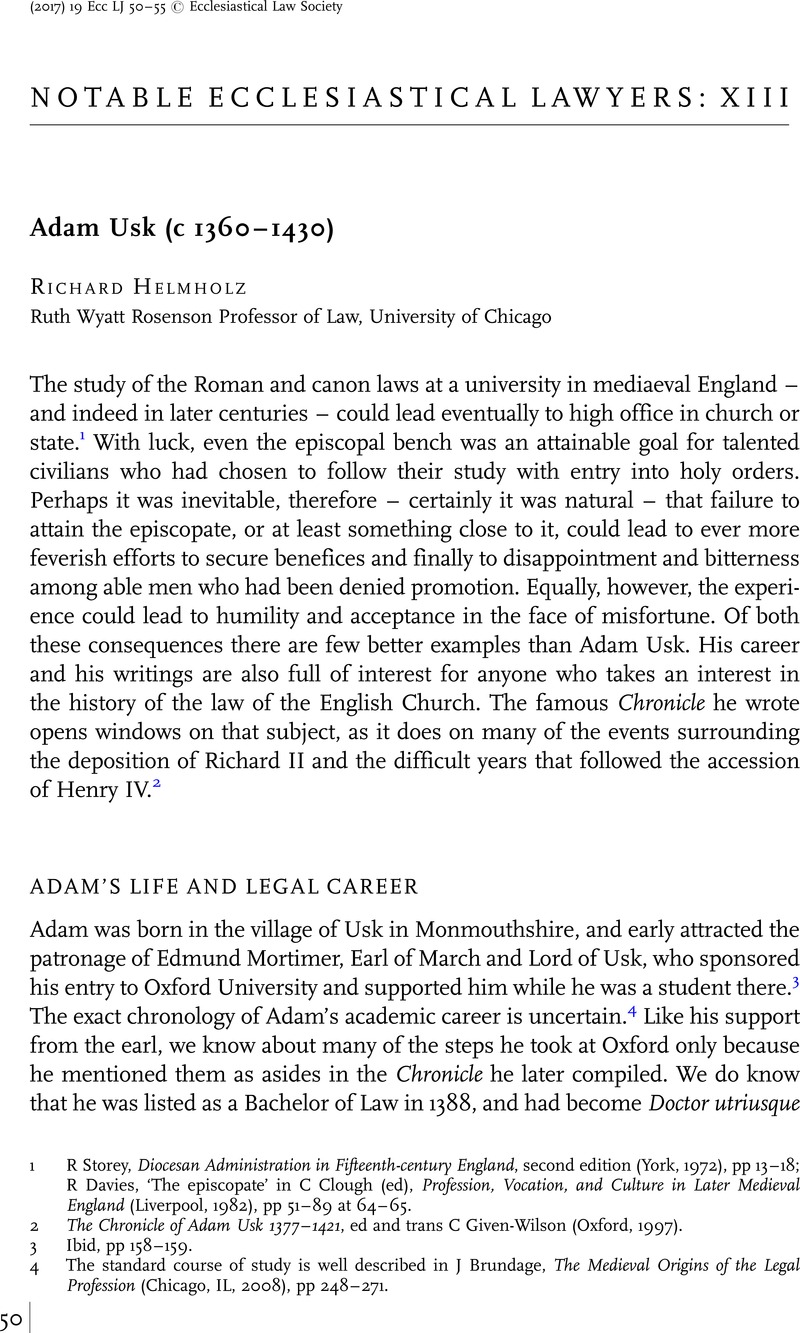No CrossRef data available.
Published online by Cambridge University Press: 20 December 2016

1 Storey, R, Diocesan Administration in Fifteenth-century England, second edition (York, 1972), pp 13–18 Google Scholar; Davies, R, ‘The episcopate’ in Clough, C (ed), Profession, Vocation, and Culture in Later Medieval England (Liverpool, 1982), pp 51–89 at 64–65Google Scholar.
2 The Chronicle of Adam Usk 1377–1421, ed and trans Given-Wilson, C (Oxford, 1997)Google Scholar.
3 Ibid, pp 158–159.
4 The standard course of study is well described in Brundage, J, The Medieval Origins of the Legal Profession (Chicago, IL, 2008), pp 248–271 CrossRefGoogle Scholar.
5 The slightly conflicting evidence for the steps and their dates is stated and discussed in Professor Given-Wilson's ‘Introduction’ to Chronicle, pp xiv–xvii; see also Given-Wilson, C, ‘Usk, Adam (c. 1350–1430)’, in Oxford Dictionary of National Biography (Oxford, 2004; online edition January 2009)Google Scholar, available at <http://oxforddnb.com/view/article/98>, accessed 16 June 2016.
6 Chronicle, pp 152–153, 250–225. See also Logan, F, The Medieval Court of Arches (Woodbridge, 2005), p 221 Google Scholar.
7 See Aston, M, Thomas Arundel: a study in church life in the reign of Richard II (Oxford, 1967), pp 368–369 and 378Google Scholar.
8 Chronicle, pp 246–247.
9 The best record of the benefices he received is contained in Emden, A, Biographical Register of the University of Oxford to A.D. 1500, vol 3 (Oxford, 1959), pp 1937–1938 Google Scholar.
10 ‘Introduction’, Chronicle, p xxiii.
11 Chronicle, pp 154–155.
12 See ‘Introduction’, Chronicle, pp xxiii–xxiv.
13 See Morris-Jones, J, ‘Adam Usk's epitaph’, (1921) 31 Y Cymmrodor 112–134 Google Scholar.
14 It is printed in Owen, E, ‘The will of Adam of Usk’, (1903) 18 English Historical Review 316–317 CrossRefGoogle Scholar.
15 Jacob, E, Essays in the Conciliar Epoch (Manchester, 1963), pp 24–25 Google Scholar.
16 Chronicle, pp 160–161.
17 Ibid, pp 62–63.
18 Sext 2.14.2.
19 Rotuli Parliamentorum, 6 vols (London, 1783), vol 3, fols 416–417.
20 On the development of this concept, see Peters, E, The Shadow King: rex inutilis in medieval law and literature, 751–1327 (New Haven, CT, 1970)Google Scholar.
21 See, eg, Lapsley, G, ‘The parliamentary title of Henry IV’, (1934) 44 English Historical Review 423–449 CrossRefGoogle Scholar, reprinted in Lapsley, G, Crown Community and Parliament in the Later Middle Ages, ed Cam, H and Barraclough, G (Oxford, 1951), pp 272–340, at 288–291, 310–321Google Scholar; Harriss, G, Shaping the Nation: England 1360–1461 (Oxford, 2005), pp 488–495 Google Scholar.
22 Caspary, G, ‘The deposition of Richard II and the canon law’ in Kuttner, S and Ryan, J (eds), Proceedings of the Second International Congress of Medieval Canon Law (Vatican City, 1965), pp 189–201 at 201Google Scholar. Some notice of Adam of Usk's account and Caspary's contribution is, however, taken in what is now the authoritative work on the reign: Saul, N, Richard II (New Haven, CT, and London, 1997), pp 418–419 Google Scholar, and also in Bennett, M, Richard II and the Revolution of 1399 (Stroud, 1999), pp 175–176 Google Scholar.
23 Chronicle, pp 24–25.
24 Ibid, pp 242–243 and 122–123.
25 Ibid, pp 120–121. See Dig. 12.2.1–42; X 2.24.1–36.
26 Chronicle, pp 132–135.
27 Ibid, pp 126–127.
28 Ibid, pp 250–251.
29 They are more fully set out in Wilkins, D, Concilia Magnae Britanniae et Hiberniae, 4 vols (London, 1737), vol 3, pp 358–368 Google Scholar.
30 See Chronicle, pp 96–97, dealing with the law of costs in the ecclesiastical forum.
31 Sext 2.14.2; Joannes Andreae was responsible for the glossa ordinaria on the texts of the Sext.
32 Chronicle, pp 82–83; the text was Cod. 10.12.2.
33 Chronicle, pp. 92–93; the texts were X 5.12.6 and Clem. 5.8.1.